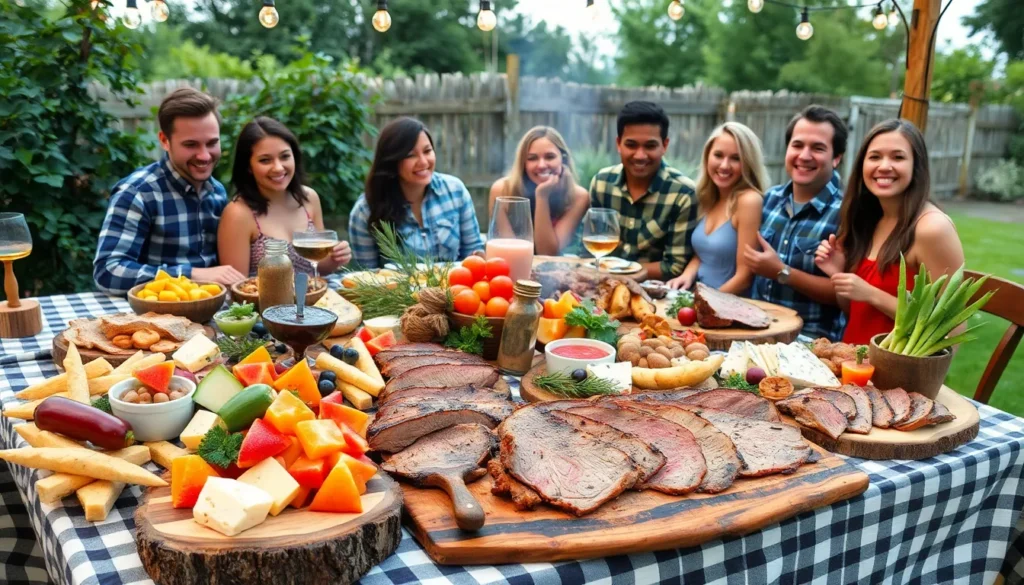Transform your next barbecue into an unforgettable feast with stunning grazing tables that’ll have your guests talking long after the last bite. We’ve discovered that combining the smoky goodness of BBQ with beautifully arranged grazing spreads creates the perfect balance of casual comfort and impressive presentation.
Gone are the days of simple potato salad and coleslaw as boring barbecue sides. Today’s BBQ grazing tables blend traditional grilled favorites with artisanal cheeses, fresh fruits, and creative accompaniments that complement those rich, smoky flavors we all crave.
Whether you’re hosting a backyard gathering or planning a large outdoor event, we’ll show you how to create Instagram-worthy grazing tables that make serving easy and eating even easier. From choosing the right boards to arranging crowd-pleasing combinations, these ideas will elevate your BBQ game and ensure every guest finds something they love.
Choose Your BBQ Grazing Table Foundation and Layout
Selecting the right foundation sets the stage for your entire BBQ grazing table presentation and determines how smoothly your outdoor gathering flows.
Select the Right Table Size and Shape
Rectangular tables work best for most BBQ grazing setups because they provide the longest surface area for arranging food. We recommend using tables that measure at least 6 feet long for groups of 8-12 people, giving you enough space to create distinct zones for meats, sides, and accompaniments.
Round tables create intimate gathering spaces that encourage conversation but limit your layout options significantly. Choose round tables only when hosting 6 people or fewer, as larger groups struggle to reach items positioned in the center.
Multiple smaller tables offer the most flexibility for larger gatherings of 15+ guests. We suggest using 2-3 coordinating tables of different heights to create visual interest while preventing overcrowding around a single serving area.
| Table Size | Guest Count | Surface Area Needed |
|---|---|---|
| 4 feet | 4-6 people | 16 square feet |
| 6 feet | 8-12 people | 24 square feet |
| 8 feet | 12-16 people | 32 square feet |
Plan Your Table Flow and Accessibility
Create logical serving zones by positioning your heaviest items like brisket and pulled pork at one end of the table. Guests naturally start with proteins first, so placing them at the beginning of your flow prevents bottlenecks during serving.
Leave 3-4 feet of walking space around all sides of your grazing table to accommodate guests moving freely. We’ve found that cramped spaces lead to awkward reaching and potential spills that can ruin your carefully arranged spread.
Position condiments and utensils at multiple points along your table rather than clustering them in one location. Place BBQ sauces, napkins, and serving spoons every 2-3 feet to eliminate the need for guests to stretch across food displays.
Establish clear entry and exit points by arranging chairs or decorative elements that guide traffic flow naturally. Start your table layout where guests will naturally approach from your outdoor kitchen or grill area.
Feature Essential BBQ Meats as Your Centerpiece
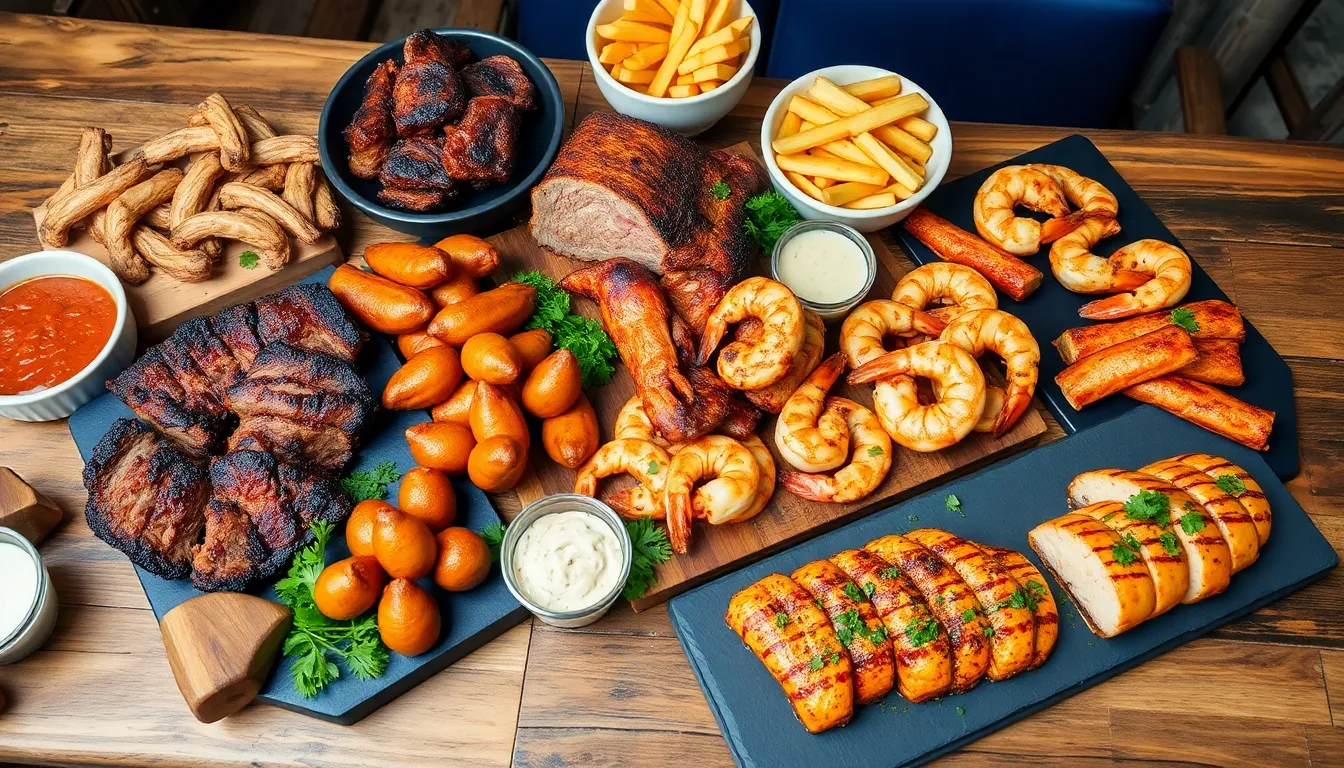
Building on your thoughtfully designed table layout, the success of your BBQ grazing table depends on selecting show stopping proteins that’ll anchor the entire spread. We recommend positioning these essential meats prominently at the center of your display to create an irresistible focal point.
Include Classic Smoked Brisket and Pulled Pork
Classic smoked brisket serves as the crown jewel of any BBQ grazing table. Slice this tender, smoky cut into thick portions that showcase the beautiful smoke ring and bark formation. Position the brisket on your largest wooden board to give it the prominence it deserves.
Pulled pork complements brisket perfectly with its tender, shreddable texture. We suggest serving this iconic BBQ staple in a rustic wooden bowl alongside small slider buns or brioche rolls. Place complementary BBQ sauces in mason jars nearby, including tangy Carolina style, sweet Kansas City, and spicy chipotle blends.
Temperature control becomes crucial when featuring these hearty proteins. Keep both meats warm using chafing dishes or slow cookers set to low heat. Fresh herbs like rosemary or thyme sprigs add aromatic appeal while maintaining the rustic BBQ aesthetic.
Add Grilled Chicken and Sausage Varieties
Grilled chicken wings provide crowd pleasing variety that appeals to all ages. Arrange different wing preparations such as buffalo, honey BBQ, and dry rubbed varieties on separate slate trays. Wings offer easy handheld convenience that works perfectly for grazing table service.
Chicken thighs deliver more flavor and moisture than traditional breast meat. We recommend grilling bone in thighs with different marinades like teriyaki, jerk seasoning, or Mediterranean herbs. Cut thighs into smaller portions for easier serving while maintaining their juicy appeal.
Sausage varieties add exceptional diversity to your protein selection. Include spicy Italian sausages, smoked bratwurst, and herbed chicken sausages sliced into bite sized rounds. Arrange these colorful options in small bowls with toothpicks for easy grabbing.
Incorporate Seafood Options Like Grilled Shrimp
Grilled shrimp skewers bring elegant sophistication to your BBQ spread. Thread large shrimp onto wooden skewers with bell peppers and red onions for added color and flavor. Position these lighter protein options at one end of your table to balance the heavier meat selections.
BBQ baked salmon offers a refined alternative for health conscious guests. Flake cooked salmon into manageable portions and serve on cucumber rounds or crackers. Cedar plank preparation adds authentic BBQ flavor while maintaining the fish’s delicate texture.
Cod cakes provide a unique twist on traditional BBQ seafood offerings. Form these into small patties and grill until golden brown with crispy exteriors. Serve warm with lemon wedges and tartar sauce in small ramekins for dipping convenience.
Create Complementary Side Dish Stations
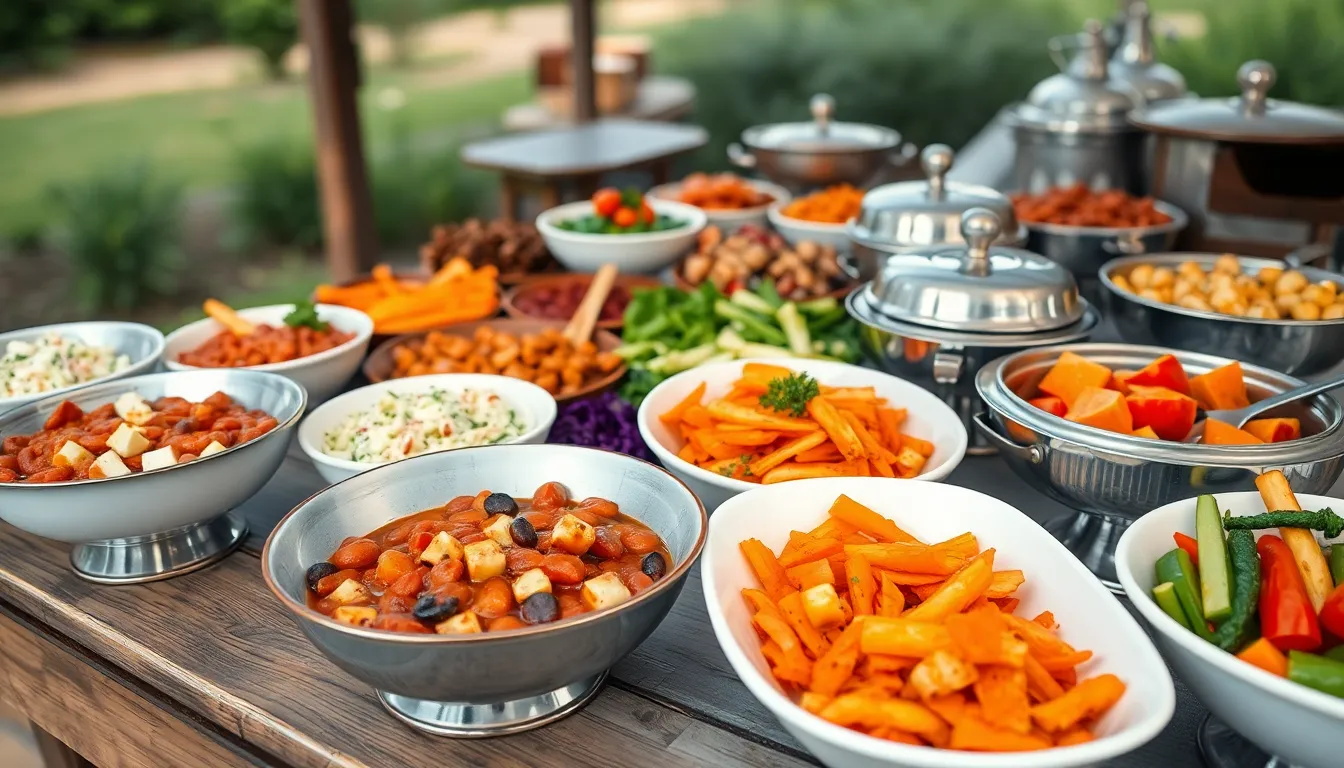
We’ll transform your BBQ grazing table by organizing sides into distinct stations that encourage guests to explore different flavor profiles and textures. This strategic approach allows everyone to customize their plates while creating an interactive dining experience.
Arrange Traditional BBQ Sides Like Coleslaw and Baked Beans
Traditional BBQ sides deserve their own dedicated station where familiar favorites shine alongside your smoked meats. We recommend positioning creamy coleslaw, hearty baked beans, and warm cornbread in attractive serving dishes that guests can easily access. These classic options provide the comfort food foundation that BBQ lovers expect.
Presenting these dishes in warmers or chafing dishes keeps everything at the perfect temperature throughout your event. We suggest using wooden serving spoons and attractive bowls to maintain the rustic BBQ aesthetic while ensuring easy serving. Place this station near your main protein area since these sides pair perfectly with smoked brisket and pulled pork.
Include Fresh Salads and Grilled Vegetables
Fresh salads and grilled vegetables create a vibrant station that balances the richness of traditional BBQ fare. We love incorporating colorful garden salads, pasta salads, and grilled vegetables like asparagus, bell peppers, and corn on the cob to add visual appeal and nutritional variety.
Grilled vegetables bring smoky flavors that complement your main proteins while offering lighter options for health conscious guests. We recommend arranging these items on elevated platters or cake stands to create visual interest and make everything easily accessible. The variety of textures and colors from fresh produce makes your grazing table more inviting and photograph worthy.
Add Comfort Food Favorites Like Mac and Cheese
Comfort food favorites deserve their own station where indulgent sides take center stage. We suggest featuring creamy mac and cheese, loaded potato salad, and buttery mashed potatoes in this section to satisfy guests craving hearty, soul warming dishes.
These warm, indulgent sides complement BBQ flavors perfectly and appeal to guests of all ages. We recommend using attractive serving bowls with warmers to keep dishes at optimal temperatures throughout your gathering. Position this station strategically so it doesn’t compete with your fresh salad area, creating a natural flow that guides guests through different flavor experiences.
Design Eye-Catching Condiment and Sauce Displays
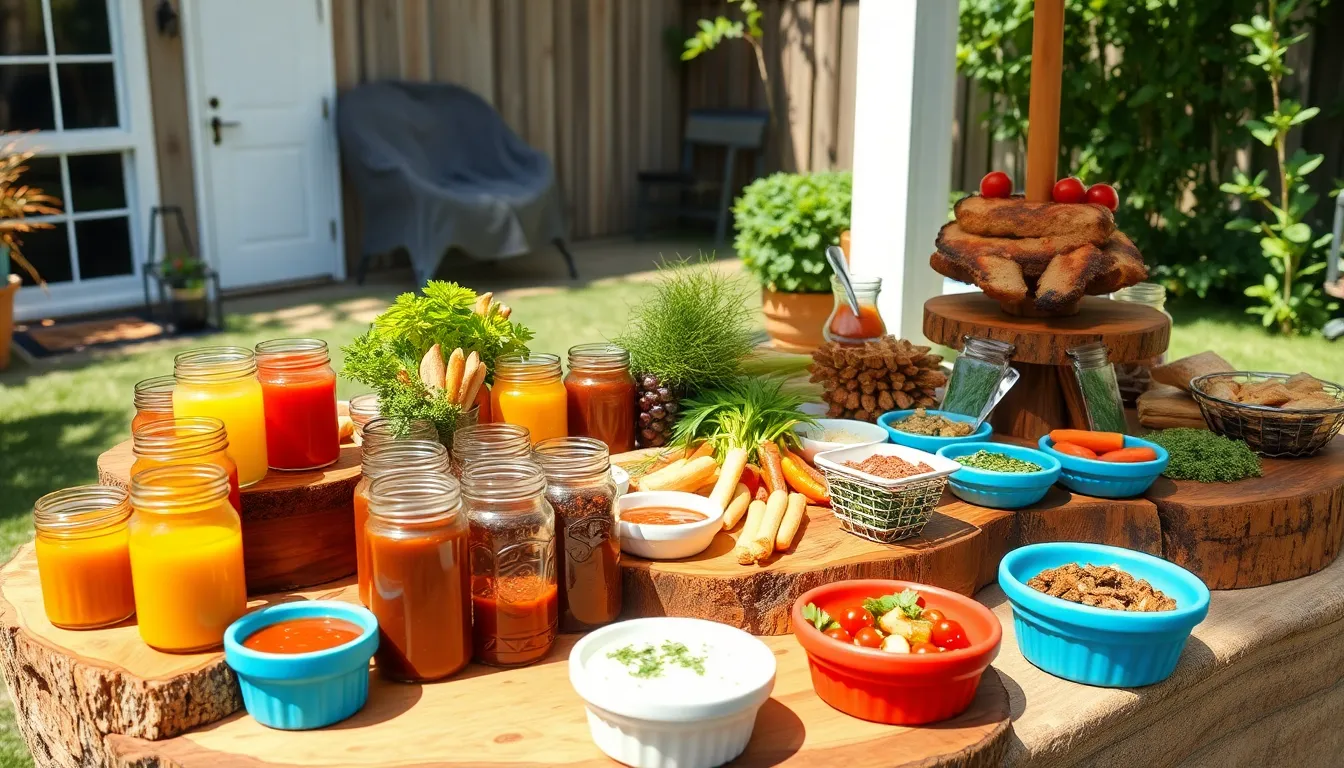
Creating visually stunning displays transforms your condiment selection into an interactive focal point that draws guests in. We recommend using small bowls, jars, or mini dispensers arranged on elevated pedestals or wooden crates to add height and dimension to your table.
Organize Various BBQ Sauce Options
Curate your sauce selection to include classic tomato-based, mustard-based, and vinegar-based BBQ sauces that cater to different regional preferences. Arrange these options from sweet and tangy to spicy and smoky varieties so guests can easily navigate their heat tolerance. Label each sauce clearly with small chalkboard signs or kraft paper tags to help visitors identify flavors before committing to a choice.
Group sauces by heat level or flavor profile using rustic wooden crates lined with kraft paper for an authentic Texas-style BBQ atmosphere. Include specialty options like chipotle peach salsa, sriracha cream, and honey mustard to broaden your flavor spectrum beyond traditional offerings. Position these unique condiments near complementary proteins like shredded chicken, meatballs, or salmon to encourage creative pairing experiments.
Include Fresh Toppings and Pickled Items
Add fresh toppings like chopped onions, sliced jalapeños, fresh herbs, and diced tomatoes in small glass bowls to brighten the rich flavors of BBQ meats. Incorporate pickled vegetables such as cucumbers, red onions, and peppers to provide tangy contrast that cuts through the richness of smoked proteins. Arrange these colorful additions using different bowl heights to create visual interest while maintaining easy access for guests.
Place pickled items in clear glass containers so their vibrant colors become part of your table’s aesthetic appeal. Offer these fresh and pickled elements as customization tools that allow guests to tailor each bite to their preferences. Position small serving spoons with each topping to maintain hygiene and prevent cross-contamination between different items.
Provide Butter, Spreads, and Specialty Condiments
Feature herb butters and flavored mayonnaises in attractive ramekins positioned near your bread and cracker stations for easy pairing. Include specialty compound butters infused with garlic, herbs, or spices that complement grilled meats and add richness to lighter options. Offer alternative spreads like guacamole, hummus, or specialty cheese spreads for guests seeking lighter or creamy accompaniments.
Present these spreads using small serving knives or spreaders to maintain presentation quality throughout your event. Balance creamy options with tangy selections to provide flavor contrast that enhances the overall grazing experience. Arrange these specialty condiments strategically between your meat stations and side dishes to encourage guests to experiment with different flavor combinations.
Incorporate Bread and Carb Options Strategically
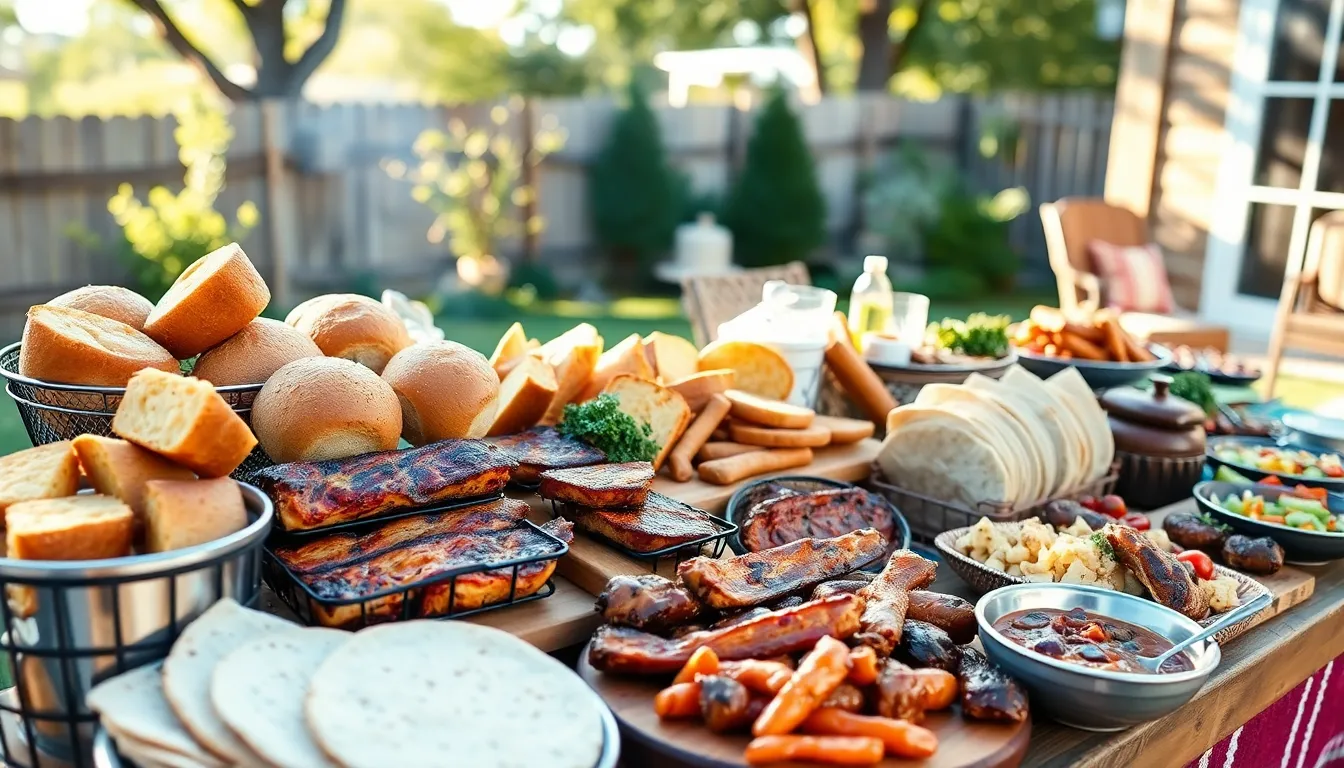
Smart bread selection transforms your BBQ grazing table from good to extraordinary by providing guests with versatile pairing options. These carb additions create perfect vessels for your carefully curated meats and sauces while adding textural variety to the overall spread.
Feature Cornbread and Dinner Rolls
Cornbread serves as the quintessential southern BBQ staple that brings authentic flavor to your spread. We love how its slightly sweet, crumbly texture complements smoky meats and creates that perfect bite when paired with savory sides like baked beans or coleslaw.
Dinner rolls offer incredible versatility that guests appreciate for creating personalized experiences. Position these soft, pillowy options near your meat stations so visitors can create mini sandwiches with pulled pork or brisket. Their neutral flavor profile makes them ideal companions for bold BBQ sauces and pickled accompaniments.
Include Slider Buns and Tortillas
Slider buns unlock endless customization possibilities for your BBQ grazing table experience. We recommend placing these perfectly sized buns adjacent to your featured meats, allowing guests to build personalized BBQ sliders with their favorite combinations of protein, sauce, and toppings.
Tortillas introduce a flexible, handheld element that expands your table’s diversity beyond traditional BBQ fare. These versatile wraps work beautifully for creating BBQ tacos or wraps, especially when paired with grilled vegetables and fresh salsas. Position them near your lighter protein options like grilled chicken or BBQ salmon for optimal guest flow.
Add Crackers and Artisan Bread Selections
Crackers bring essential crunchiness that contrasts beautifully with tender BBQ meats and creamy sides. We strategically place various cracker types near cheese selections and specialty spreads, creating natural dipping opportunities that encourage guests to experiment with flavor combinations.
Artisan breads elevate your grazing table with rustic charm and sophisticated flavors. Consider offering baguette slices, ciabatta chunks, or sourdough rounds that guests can layer with BBQ meats, aged cheeses, or pickled vegetables. Slice these breads in varying thicknesses to accommodate different serving preferences and create visual interest on your display boards.
Add Fresh Elements for Balance and Color
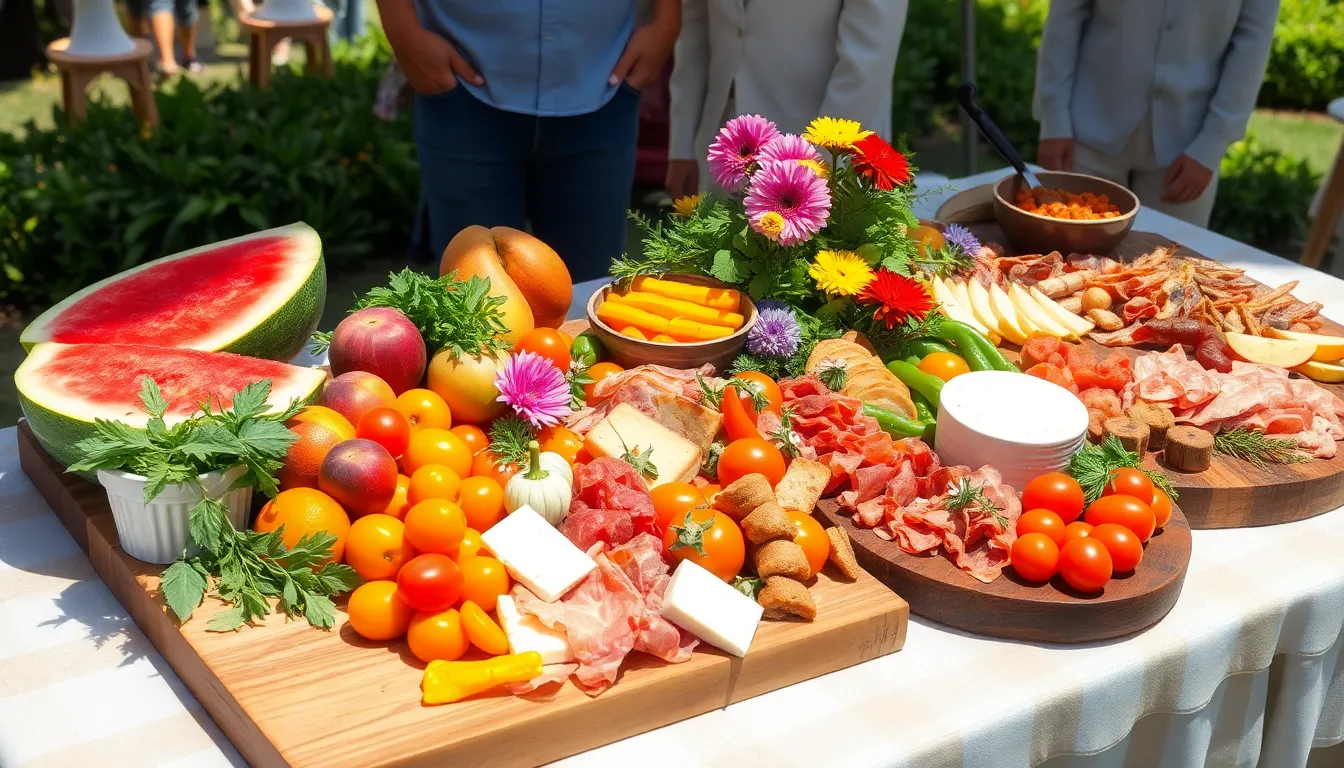
Building on our carefully arranged condiments and breads, we’ll now focus on incorporating vibrant fresh elements that bring visual appeal and palate cleansing qualities to our BBQ grazing table. Fresh ingredients provide the perfect counterpoint to rich, smoky flavors while creating stunning color contrasts.
Include Seasonal Fruits and Raw Vegetables
Seasonal fruits and raw vegetables add natural sweetness and refreshing crunch that beautifully complements smoky BBQ flavors. Watermelon and peaches deliver juicy sweetness during summer months, while their bright colors create eye-catching focal points on your table. Cherry tomatoes, sliced cucumbers, and colorful bell peppers provide crisp textures and vibrant hues that refresh the palate between bites of rich meats.
We recommend arranging these fresh elements around your main dishes rather than clustering them in one area. Sliced stone fruits like peaches or plums pair exceptionally well with pulled pork, while cucumber rounds offer a cooling contrast to spicy BBQ sauces. Bell pepper strips in red, yellow, and orange create natural rainbow accents that draw guests’ attention and provide healthy options for lighter appetites.
Arrange Cheese and Charcuterie Accents
Assorted cheeses and charcuterie selections elevate your BBQ grazing table by introducing sophisticated flavors and textures. We suggest including both soft cheeses like brie or goat cheese and hard varieties such as aged cheddar or gouda to provide diverse taste experiences. Cured meats including prosciutto, salami, and chorizo complement BBQ proteins while adding European flair to your spread.
Arrange these elements on kraft paper or rustic wooden boards to maintain your BBQ aesthetic. Roll prosciutto slices into elegant rosettes, cube harder cheeses for easy serving, and fan salami slices in overlapping patterns. Crackers, mixed nuts, and artisanal dips should be positioned nearby to complete the charcuterie experience and encourage guests to create their own flavor combinations.
Incorporate Herbs and Garnish Details
Fresh herbs like rosemary, thyme, basil, and parsley serve dual purposes as both flavor enhancers and decorative elements throughout your grazing table. We recommend using small herb bunches as natural garnishes on serving plates and sprinkling individual leaves strategically around dishes to add color and aroma. Rosemary sprigs work particularly well as rustic accents near grilled meats, while basil leaves brighten tomato-based sides.
Lemon wedges, edible flowers, and microgreens provide additional garnish options that brighten your presentation. These finishing touches demonstrate attention to detail and create Instagram-worthy moments for your guests. Strategic placement of these garnishes fills empty spaces on your table while maintaining the overall cohesive design of your BBQ spread.
Plan Your Serving Tools and Accessibility

Creating a functional BBQ grazing table goes beyond arranging delicious food – it requires strategic planning of tools and guest flow. We’ll transform your spread into an efficient serving station that keeps guests happy and prevents bottlenecks.
Provide Appropriate Utensils for Each Item
Tongs become essential for handling grilled meats like brisket, pulled pork, and chicken skewers without making a mess. Small serving forks work perfectly for cheese selections and charcuterie items, while dedicated spoons prevent cross-contamination between different sauces and dips.
Toothpicks and skewers make bite-sized items manageable for guests handling veggie kebabs or bacon-wrapped appetizers. Stack napkins and small plates at multiple points around the table so guests don’t need to search for serving essentials.
Individual serving utensils for each dish maintain food safety and prevent flavor mixing between items. Place these tools directly beside their corresponding foods rather than grouping them in one location.
Label Items for Guest Convenience
Clear labeling eliminates guesswork and helps guests with dietary restrictions quickly identify suitable options. Write labels for gluten-free items like sriracha meatballs or paleo-friendly baked salmon using small chalkboard signs or tent cards.
Dietary indicators become crucial when serving items that may contain common allergens or follow exact eating plans like Whole30. Include heat level warnings for spicy BBQ sauces and indicate which items are vegetarian or vegan-friendly.
Simple descriptions enhance the experience by highlighting special ingredients or preparation methods. “Honey Bourbon Glazed Ribs” sounds more appealing than just “Ribs” and helps guests make informed choices.
Ensure Easy Flow and Multiple Access Points
Multiple serving sides prevent crowding and create smooth traffic flow around your grazing table. Position the table on a kitchen island or use a long rectangular setup that allows guests to approach from both sides simultaneously.
Strategic placement of high-demand items across different areas prevents bottlenecks at popular stations. Distribute crowd favorites like pulled pork sliders and cheese selections to opposite ends of the table.
Visual height variations using wooden boards and cake stands make items accessible while creating an appealing display. Fill empty spaces with decorative fruits, fresh herbs, or small condiment bowls that guests can also enjoy while grazing.
Clear pathways around the table ensure wheelchair accessibility and accommodate guests with mobility needs. Leave at least three feet of space on all accessible sides for comfortable maneuvering.
Style Your BBQ Grazing Table with Themed Decor
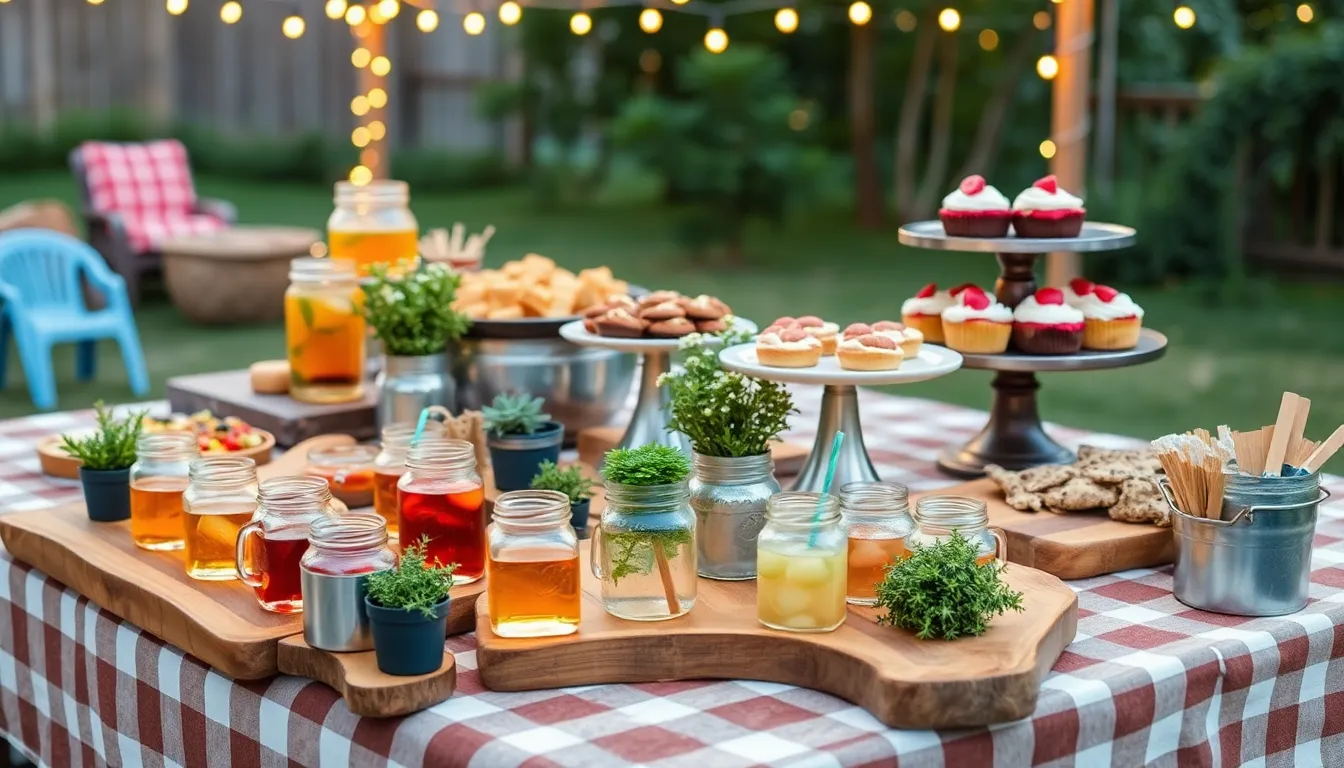
Transforming your BBQ grazing table into a cohesive visual experience requires thoughtful attention to themed elements that complement your carefully arranged foods. Creating a unified aesthetic enhances the overall atmosphere and makes your spread even more memorable for guests.
Use Rustic and Outdoor-Inspired Elements
Natural textures bring authenticity to your BBQ grazing table setup. Wooden boards serve as perfect serving platters while wood slices create rustic chargers for individual portions. Kraft paper functions as an affordable table runner that adds warmth without overwhelming your display.
Checkered tablecloths instantly evoke classic picnic vibes that pair beautifully with grilled meats and fresh vegetables. Small potted herbs like rosemary or thyme double as both decor and functional garnishes for your BBQ dishes. Burlap accents create texture contrasts that highlight the colors of your sauces and sides.
Mason jars work perfectly for serving drinks or holding utensils while maintaining the outdoor theme. Galvanized metal containers add industrial charm and provide practical storage for napkins or condiment packets. These elements create visual cohesion that ties your entire grazing table together.
Incorporate Height Variations with Risers and Stands
Visual interest comes from creating multiple levels across your grazing table surface. Cake stands elevate desserts and specialty items while wooden risers showcase your main BBQ proteins prominently. Sturdy boxes covered with themed fabric or kraft paper create custom platforms for different food categories.
Stack wooden boards at varying heights to maximize your table space effectively. Start by positioning your largest protein dishes on elevated platforms then fill gaps with complementary sides and condiments. This layering technique allows guests to easily view and access all offerings without crowding around exact areas.
Vintage crates turned on their sides create natural shelving for bottles and jars. Different sized cutting boards create natural tiers when stacked strategically throughout your display. These height variations guide the eye across your spread and create ever-changing visual flow.
Add Lighting and Ambient Details
Soft ambient lighting transforms your BBQ grazing table into an inviting focal point for evening gatherings. String lights draped above the table create a warm glow that highlights food colors and textures beautifully. Battery operated LED strips tucked under risers provide subtle uplighting that makes dishes appear more appetizing.
Lanterns positioned at table corners add rustic charm while providing practical illumination for serving areas. Pillar candles in hurricane glass protect flames from outdoor breezes while creating intimate atmosphere. Solar powered stake lights around the table perimeter extend the lighting scheme beyond your immediate serving area.
Mason jar luminaries filled with battery operated fairy lights combine themed decor with functional lighting. Citronella candles serve dual purposes by providing ambiance while naturally deterring insects from your food display. This strategic lighting approach creates a cozy environment that encourages guests to linger and enjoy the BBQ experience.
Consider Dietary Restrictions and Alternatives

Creating an inclusive BBQ grazing table means ensuring every guest can enjoy the feast regardless of their dietary needs. We’ll show you how to accommodate various restrictions while maintaining the delicious flavors and visual appeal that make grazing tables so appealing.
Include Vegetarian and Vegan BBQ Options
Vegetarian guests deserve equally exciting options that don’t feel like afterthoughts on your BBQ spread. Start with protein-rich vegan pâtés made from lentils and walnuts as stunning centerpieces that rival traditional meats. Create dedicated sections featuring plant-based alternatives like grilled portobello mushrooms, BBQ jackfruit, and seasoned tempeh that capture those beloved smoky flavors.
Fresh vegetables bring vibrant colors and satisfying crunch to balance heavier items. Arrange leafy greens, crisp carrots, and colorful radishes alongside grilled bell peppers and roasted tomatoes. Include fermented options like kimchi and pickles that add tangy complexity while supporting digestive health.
Nuts such as almonds, cashews, and walnuts provide essential proteins and healthy fats that keep plant-based guests satisfied. Feature multiple vegan cheese varieties alongside traditional dairy options, ensuring clear separation to prevent cross-contamination. Offer diverse dips including several hummus varieties, vegan ranch, and herb-based spreads that complement both vegetables and crackers.
Provide Gluten-Free Alternatives
Gluten-free guests shouldn’t miss out on the bread and cracker experience that makes grazing tables so interactive. Replace traditional wheat-based items with certified gluten-free crackers, rice cakes, and specialty breads that maintain structural integrity for building perfect bites. Source high-quality gluten-free options that taste just as satisfying as their wheat counterparts.
Protein selections require careful attention to preparation methods and marinades. Choose naturally gluten-free options like grilled salmon, herb-crusted chicken, and meatballs made with gluten-free breadcrumbs or almond flour. Ensure all marinades and sauces are free from wheat-based thickeners and soy sauce containing gluten.
Verify that condiments and dips meet gluten-free standards, as many commercial varieties contain hidden wheat ingredients. Create separate serving areas for gluten-free items to prevent cross-contamination from regular breads and crackers. Label these sections clearly so guests can confidently make their selections.
Label Allergen Information Clearly
Clear labeling transforms your grazing table from potentially stressful to completely enjoyable for guests with food allergies. Create attractive tent cards or small signs that identify major allergens including nuts, dairy, soy, eggs, and gluten in each dish. Use consistent symbols or color coding that guests can quickly recognize across your entire spread.
Separate high-allergen items like nuts and dairy products from allergen-free options using distinct serving areas and dedicated utensils. Position nut-containing items away from other foods to prevent accidental contamination through shared serving tools or airborne particles. Provide individual serving spoons for each item rather than allowing guests to use the same utensil across multiple dishes.
Consider creating a simple allergen reference card that guests can take with them as they move around the table. Include your contact information for guests who need additional details about ingredients or preparation methods. This proactive approach shows thoughtfulness while giving everyone confidence to fully enjoy your carefully crafted BBQ grazing experience.
Time Your Setup for Maximum Freshness
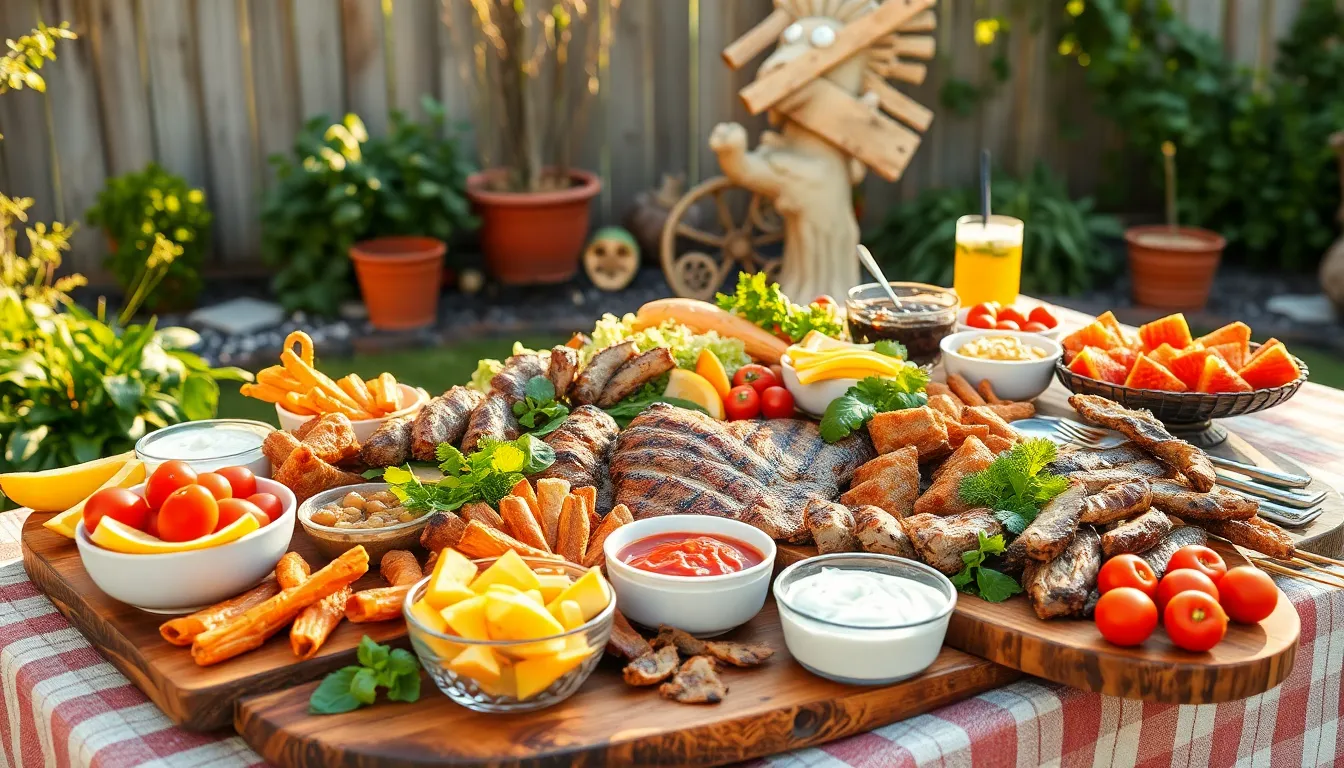
Creating a stunning BBQ grazing table requires strategic timing to ensure every element maintains its optimal quality and visual appeal. Fresh presentation directly impacts guest satisfaction and food safety.
Plan Your Preparation Timeline
We recommend deciding on at least five items to serve, starting with your protein sources like grilled meats or seafood, then adding complementary sides, condiments, and desserts. Prepare main dishes ahead of time whenever possible, such as BBQ baked salmon, sriracha meatballs, shredded chicken, or cod cakes to save valuable time on event day. Slow cooker or instant pot options simplify cooking while keeping food moist and flavorful throughout your gathering.
Strategic advance preparation allows you to focus on final touches and guest interaction rather than scrambling with last-minute cooking. Map out your cooking schedule working backward from serving time, accounting for resting periods for meats and chilling time for cold items. Advanced preparation also ensures consistent quality across all dishes, preventing the stress of simultaneous cooking that can compromise food safety and presentation.
Keep Hot Items Warm and Cold Items Chilled
Cook or prepare hot items shortly before serving and maintain proper temperatures using warming trays or insulated containers until guests arrive. Use serving boards or trays with built-in insulation or elevate hot plates over heat sources to preserve warmth throughout your event. Temperature maintenance prevents bacterial growth and ensures optimal flavor profiles for all hot dishes.
Cold items like salads, fruits, cheeses, and dips should remain chilled until just before placing them on the table to retain maximum freshness. Incorporate bowls with ice or use chilled serving platters to prevent warming from ambient temperatures during service. Strategic temperature control maintains food safety standards while preserving the intended textures and flavors that make each item shine.
Arrange Items Just Before Serving
Arrange items on the grazing table immediately before serving to ensure everything looks fresh and appealing to your guests. Start placing larger protein dishes and main boards first, then fill spaces with sides, crackers, fruits, nuts, and condiments for optimal visual flow. Final arrangement timing prevents wilting, condensation, and temperature fluctuations that can compromise both appearance and taste.
Visual presentation reaches its peak when items are arranged at their optimal temperatures and textures. Last-minute arrangement also allows you to make final adjustments based on guest count and ensures that delicate items like fresh herbs and garnishes maintain their vibrant appearance throughout the event.
Conclusion
Creating the perfect BBQ grazing table transforms your outdoor gathering from a simple meal into an unforgettable experience. We’ve shown you how thoughtful planning—from selecting the right table layout to incorporating diverse proteins and fresh elements—elevates your barbecue beyond traditional expectations.
The key lies in balancing functionality with visual appeal while ensuring every guest feels included. By implementing strategic serving zones clear labeling and accommodating dietary restrictions you’ll create a seamless dining experience that encourages mingling and exploration.
Your BBQ grazing table becomes more than just food presentation—it’s the centerpiece that brings people together. With proper timing attention to detail and these proven strategies you’re ready to host memorable gatherings that’ll have your guests talking long after the last bite.
Frequently Asked Questions
What is a BBQ grazing table?
A BBQ grazing table is an elevated approach to outdoor dining that combines traditional barbecue favorites with artisanal cheeses, fresh fruits, and creative sides. It moves beyond typical BBQ sides like potato salad and coleslaw, creating a visually appealing spread that enhances the casual yet impressive atmosphere of outdoor gatherings.
What table shape works best for BBQ grazing tables?
Rectangular tables are recommended for larger groups as they provide more surface area and better accessibility. Round tables work better for smaller, intimate gatherings. For larger events, consider using multiple smaller tables for flexibility and to prevent crowding around a single serving area.
Which BBQ meats should be featured as the centerpiece?
Classic smoked brisket and pulled pork should be showcased prominently, along with grilled chicken and various sausages for protein diversity. Adding grilled shrimp and BBQ baked salmon brings sophistication and caters to health-conscious guests while maintaining the BBQ theme.
How should I organize side dishes on the grazing table?
Create dedicated stations for different types of sides. Set up a traditional BBQ station with coleslaw, baked beans, and cornbread. Include a fresh station with salads and grilled vegetables for vibrancy. Comfort foods like mac and cheese should have their own station to satisfy hearty cravings.
What condiments and sauces should I include?
Curate a variety of BBQ sauces and label them clearly, grouping by heat level or flavor profile to cater to regional preferences. Include fresh toppings, pickled items, butter, spreads, and specialty condiments. This creates an interactive focal point and allows guests to customize their meals.
What bread and carb options work best?
Feature cornbread and dinner rolls for versatile pairing options. Include slider buns and tortillas for guests to create personalized BBQ sliders and wraps. Add crackers and artisan bread selections for crunch and sophistication, encouraging guests to experiment with different flavor combinations.
How can I add fresh elements for balance?
Incorporate seasonal fruits and raw vegetables to complement smoky BBQ flavors and provide palate cleansing. Arrange these vibrant ingredients around main dishes for visual appeal. Add assorted cheeses and charcuterie for sophisticated flavors, plus fresh herbs and garnishes for decorative elements.
What serving tools and accessibility features are important?
Provide appropriate utensils for each item, such as tongs for meats and small serving forks for cheeses. Use clear labeling for dietary restrictions. Ensure easy flow with multiple access points around the table and create logical serving zones to prevent crowding.
How should I style the BBQ grazing table?
Use rustic and outdoor-inspired elements like wooden boards, checkered tablecloths, and mason jars. Incorporate height variations with risers and stands for visual interest. Add ambient lighting such as string lights and lanterns to create an inviting focal point for evening gatherings.
How can I accommodate dietary restrictions?
Include vegetarian and vegan options like protein-rich vegan pâtés and grilled portobello mushrooms. Provide gluten-free alternatives with certified crackers and ensure proteins and condiments meet gluten-free standards. Use clear allergen labeling and separate serving areas for high-allergen items.
What’s the best timing for setting up the grazing table?
Plan a preparation timeline starting with protein sources, then adding sides, condiments, and desserts. Prepare main dishes in advance and use warming trays for hot items and insulated containers for cold items. Arrange everything just before serving to maintain optimal visual appeal and food safety.

